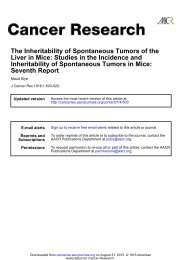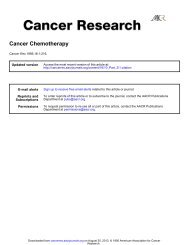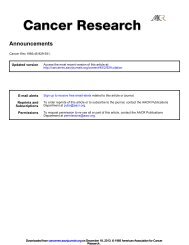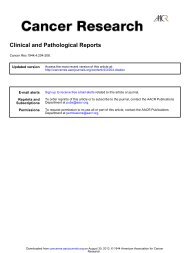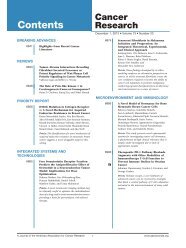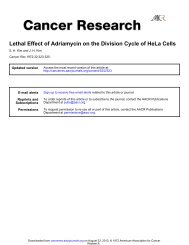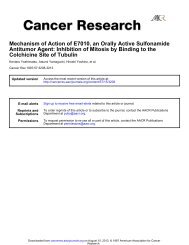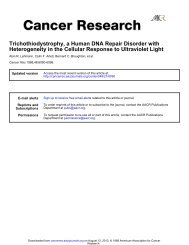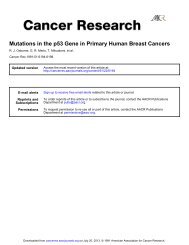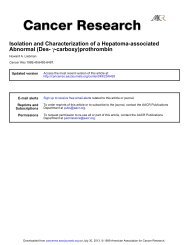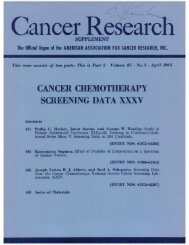XANTHOMA OF THE BREAST In a series of nine hundred (circa ...
XANTHOMA OF THE BREAST In a series of nine hundred (circa ...
XANTHOMA OF THE BREAST In a series of nine hundred (circa ...
You also want an ePaper? Increase the reach of your titles
YUMPU automatically turns print PDFs into web optimized ePapers that Google loves.
Downloaded from cancerres.aacrjournals.org on December 28, 2013. © 1932<br />
American Association for Cancer Research.<br />
<strong>XANTHOMA</strong> <strong>OF</strong> <strong>THE</strong> <strong>BREAST</strong><br />
CUSHMAN D. HAAGENSEN, M.D.<br />
(From the Memorial Hospital, New York)<br />
<strong>In</strong> a <strong>series</strong> <strong>of</strong> <strong>nine</strong> <strong>hundred</strong> (<strong>circa</strong>) tumors <strong>of</strong> the breast in which<br />
the preoperative diagnosis was carcinoma, histologic examination<br />
showed that in three instances the lesion was a xanthoma. Although<br />
the diagnostic error in reference to xanthoma was, therefore,<br />
small, the rarity <strong>of</strong> these tumors and their relation to abnormal<br />
lipoid metabolism prompts a discussion <strong>of</strong> them, as well as <strong>of</strong><br />
the xanthomatous degenerative processes occurring secondarily in<br />
inflammations and in true neoplasms in the breast.<br />
Xanthomas are apparently not true neoplasms. A neoplasm<br />
has been defined as a more or less circumscribed collection <strong>of</strong> cells<br />
arising wholly independently <strong>of</strong> the rest <strong>of</strong> the body, in general growing<br />
progressively, and serving no useful purpose in the organism.<br />
Xanthomas violate the second premise in the definition, for they<br />
have been shown by blood chemistry determinations to be related<br />
to an abnormal lipoid metabolism. Before the development <strong>of</strong><br />
the modern quantitative methods <strong>of</strong> blood chemistry which enabled<br />
this factor to be proved, there were well known clinical findings<br />
which suggested it. Xanthomas were known to be most frequent<br />
in elderly individuals with diseases <strong>of</strong> the liver, particularly those<br />
complicated by icterus, with nephritis, and with diabetes. Hutchinson,<br />
Sangster and Crocker, for instance, found that four-fifths<br />
<strong>of</strong> the 28 cases <strong>of</strong> xanthoma multiplex which they collected in 1882<br />
were associated with chronic jaundice. Torok made a similar<br />
report. Chauffard and Laroche in 1911 first made blood cholesterin<br />
determinations in cases <strong>of</strong> xanthoma and found the cholesterin<br />
content to be distinctly elevated. This finding has since<br />
been verified by many workers. It has even been shown that when<br />
the blood cholesterin falls as the result <strong>of</strong> the administration <strong>of</strong><br />
a cholesterin-free diet or because <strong>of</strong> treatment <strong>of</strong> coexisting diabetes,<br />
the xanthomas may disappear. Xanthomas are thus the local<br />
manifestation <strong>of</strong> a syndrome which may be called xanthomatosis.<br />
<strong>THE</strong> CLASSIFICATION <strong>OF</strong><br />
<strong>XANTHOMA</strong>S<br />
The term xanthoma covers such a variety <strong>of</strong> disease types that<br />
it would appear that the understanding <strong>of</strong> xanthomas <strong>of</strong> the breast<br />
1077



